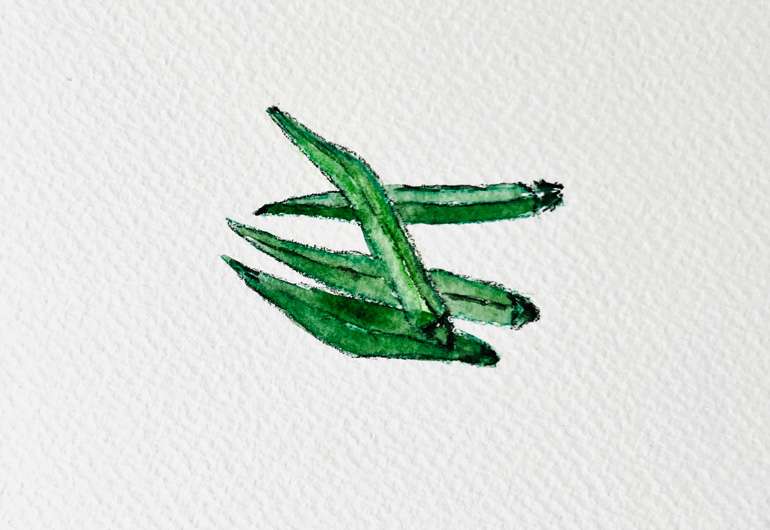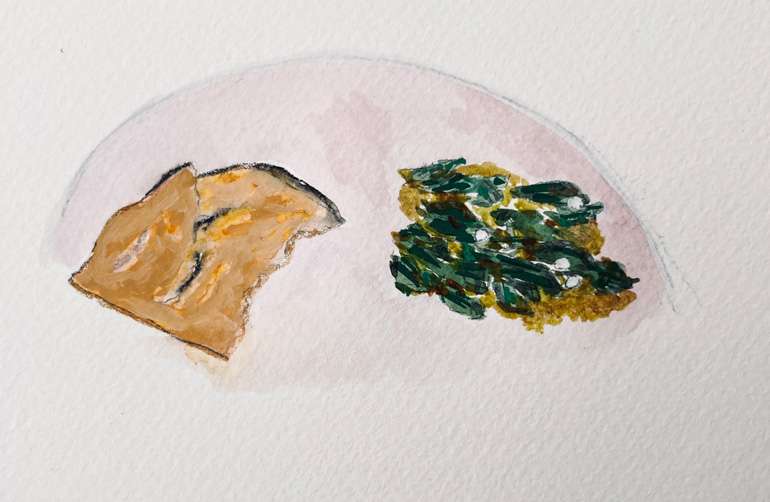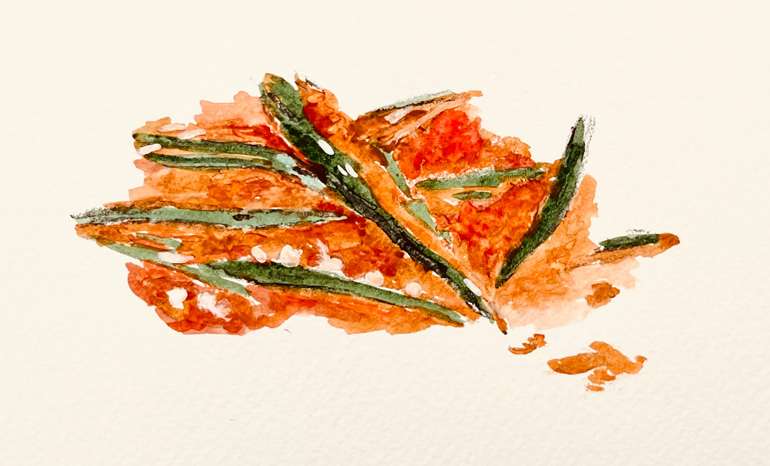
I am at my sister’s house in Patna. Whenever I come to Patna, during periods when my college is closed for either summer or winter holidays, I mostly eat at home. There must be fine restaurants in town but these aren’t the places I knew in my youth; the food that I get at home here also reminds me of my mother’s dishes.
Meena, who cooks for my sister, is an Adivasi woman from Netarhat in Jharkhand. She is a marvelous cook. This morning my sisters and I went walking in the park in front of the house. Then my sister bought karela (Google tells me that the English name for it is bittergourd) and I’m looking forward to eating that along with the rohu fish that Meena is frying right now. I also bought bunches of makoi (is gooseberry the correct translation?) and my fond hope that they will be sweet. But what I’m most looking forward to is the bhindi.
I grew up knowing that bhindi is known as lady’s fingers in India. After moving to America, I discovered that it was called okra in many countries. I can honestly say that I have eaten okra in America but rarely have I eaten bhindi. What I mean by this is that the form in which I get to eat it is mostly in dishes like gumbo where the mucilaginous part of the vegetable, the slime that coats your fingers when you chop it, is used as a thickener. You can order a dish of shrimp gumbo, or some kinds of soup, and you will see thin laterally-cut okra slices in the dish placed before you. In the southern parts of America in particular, you can find it also in other forms. I have a memory from my early years in the U.S. I was driving through Georgia (I was enroute to Florida, where I had been given my first teaching job) and saw fried okra on the menu. Here was my chance to eat bhindi! But what was put in front of me was something I hadn’t eaten before: whole bhindi dipped in batter, and with spices that weren’t my spices, and served with some kind of bread. I’m sure I finished it all, but it was not entirely satisfying.
What Meena will cook for us right now is going to be different. When she has heated the oil in the karahi, she will put cumin seeds and dried chillies before adding the bhindi that has been cut in small pieces. (I haven’t seen Meena ever put methi seeds, fenugreek, but I recall my mother used to do that. This is a small difference but when I mentioned this to my sister, she said yes, just the mention of methi brings back the fragrance from the kitchen when our mother used to cook.) After sauteing for a while, Meena will add turmeric and salt. She might also put in thinly-sliced onions toward the end. The result will be a crispy, crunchy bhujiya that goes perfectly with hot, fluffy chapatis.
A couple of weeks ago, I was in Kochi for three days and, until the last night when I ate seafood, I ate the same dish twice daily at a cheap vegetarian restaurant near my hotel: bhindi fry with tandoori roti. This was the first time I was eating bhindi with curry leaves; I liked it immensely. I remember clearly the fine bhindi and chapati I ate at a roadside hotel on my way back to Mumbai from the Konkan coast in the rain about a decade ago. Even better was the bhindi and roti I ate with two Bastar journalists when we were coming back to Raipur after visiting Soni Sori in 2017. Why do I remember these distant meals? Probably because of a mix of hunger and satisfaction: the deep craving during a long period of travel on the road and then the discovery of a perfect dish. The combination of bhindi and roti, particularly with a side of tadka dal, is the ideal food for the India highway. These items are easy to make, not requiring elaborate kitchens, and when consumed they don’t sit heavily in the stomach.

Meena knows that she shouldn’t cook the bhindi by cutting off the tips and after making long cuts with a drizzle of besan and spices and aamchur. It makes for an interesting dish after the bhindi has been deep-fried. I don’t quite like the other version either where the bhindi is sauteed and set aside and then a gravy prepared. I have seen Kitchen King on Meena’s counter; I think of Kitchen King as performing the role that maxie plays in the lives of women in India, an item to be used in all sorts of situations. It is a convenient thing but doesn’t make for anything distinctive.

I’m extending this meditation further into the subjunctive: when I’m done eating the bhindi that Meena is making, I will eat the makoi we bought this morning. By now I’m quite sure that they will be sweet. This morning, as I approached the woman sitting on the pavement with a basket of the fruit in front of her, I asked my younger sister if she remembered the woman. She did. When we went close, the fruit seller, a round-faced, middle-aged woman, said that she hadn’t seen me for a long time.
For about ten previous days before my father’s death, I had been buying makoi from that same woman. I would buy several bunches and take them to the hospital where my sisters were sitting vigil beside our father in the ICU. On the last morning, my younger sister was with me, and I felt compelled to introduce the two women. I remember I was leaning over her basket, choosing the fruit. I said to the fruit-seller that this was the sister for whom I had been taking the makoi each day to the hospital. At which the woman good-heartedly said, Bhaiya, sab theek ho jayega.
This statement, a sympathetic assurance that things would turn out okay, when in fact in my heart I knew that we were standing at a precipice and tragedy was close, moved me immensely. You can sometimes offer words even to a stranger that are as sweet as a bunch of makoi.



Your essay is so evocative that I am craving some bhindi right now. With hot phulkas.
Lady’s finger is one of my favorite vegetables.
Such a detailed and deep story of personal feelings and of loss. Lovely read.
“The combination of bhindi and roti, particularly with a side of tadka dal, is the ideal food for the India highway.” Are you sure you’re not my paati? PS: Paati is grandma in Tamil.
After reading this, bhindi has become more palatable for me.
Bhindi ,present in perhaps so many kitchens in all the states is so much a part of our everyday buys.
But here , now elevated by you, Mr Amitava ,it rises ,gets a status of being more than a favourite vegetable,becomes a story with a memory ,a star in a collection of happy thoughts of food n fun reading!
Loved “You can sometimes offer words even to a stranger that are as sweet as a bunch of makoi”.